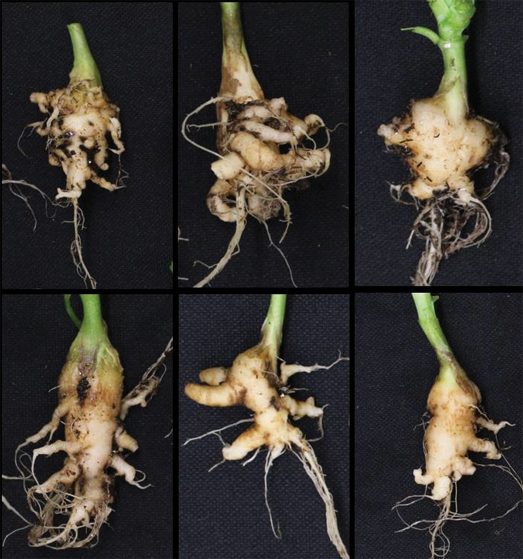Diversity in clubroot pathotypes, diversity in clubroot resistance
Key result: With tools to identify various clubroot pathotypes, researchers tested existing clubroot-resistant (CR) cultivars against the new 5X pathotype found in Alberta soils. They found that several were resistant to 5X.
Project title, Principal investigator: “Developing canola germplasms with diverse mechanisms to enhance the durability of clubroot resistance,” Gary Peng, AAFC Saskatoon
Funding: SaskCanola and Western Grain Research Foundation
The first clubroot-resistant (CR) canola cultivar was released in 2009 as a new management tool to counter the disease that had been found in canola fields in Alberta. Then in 2013 some canola fields seeded with CR varieties showed substantial levels of clubroot damage. When further examination determined that the pathogen strains from these fields were virulent (the ability to infect or damage the host) to all the resistant cultivars in the marketplace, the new pathogen strain was tentatively called pathotype 5X. This incited a renewed need for new clubroot resistant varieties which would be resistant to additional pathotypes instead of just pathotype 3, which had been the most common strain on the Prairies.
Consequently, the goal of this study was to assess previously identified CR genes to see if any would have efficacy against pathotype 5X of P. brassicae. As well, it aimed to explore molecular and biochemical tools that can be used for studying CR mechanisms, and develop canola germplasm carrying more diverse CR genes for sustainable clubroot resistance.
First, 24 CR lines from Agriculture and Agri-Food Canada (AAFC) were screened against a mixture of three populations of the pathotype 5X from Alberta fields where resistant cultivars failed in 2013. These populations showed variable virulence against resistant canola cultivars, with some populations being slightly more virulent on resistant varieties. Luckily, several CR genes and lines were resistant to the mixed 5X populations.
Then, new AAFC CR brassica candidate lines were screened against the mixed 5X populations, including those lines carrying the CR genes identified previously from B. rapa and B. nigra. Many of these CR candidates showed resistance to all other P. brassicae pathotypes (2, 3, 5, 6 and 8) found in Canada earlier. Many of these CR genes have now been mapped, with robust markers developed.

Advanced technologies were then explored to better understand the resistance mechanisms associated with specific CR genes, including transcriptome (RNA-seq), proteome, metabolome, fluorescent microscopy and synchrotron-based chemometrics.
Finally, germplasms carrying different CR genes were developed. Clubroot resistant B. napus germplasm carrying different CR genes were transferred to seven breeding companies for clubroot resistance breeding. B. napus germplasm carrying double CR genes (on chromosome A03 and A08) was also produced, which showed moderate but consistent resistance to pathotype 5X populations through collaboration with Nutrien Ag Solutions (formerly Crop Production Services). An elite line of B. carinata carrying a CR gene was also stabilized and can be used for commercial variety development. Elite AAFC B. napus lines (black- and yellow-seeded) carrying a CR gene have also been produced and the black-seeded lines have been tested in the field. These CR genes can be pyramided in commercial breeding lines for canola hybrids with resistance against a broader range of pathotypes.
Compare varieties, including CR varieties, with the CPT online tool
Canola Performance Trials provide independent third-party canola variety comparison data from locations all across the Prairies. Data is coming in for 2018 and data from 2011 to 2017 is available any time at canolaperformancetrials.ca.
The online search tool, situated at the bottom of the CPT home page, allows users to filter by herbicide-tolerance system, location, yield, maturity and more. With each search result, scroll down to get a graph of the results, then a ‘Trial results data’ table and then a map showing trial locations. To see how two varieties performed when together in the same location, click ‘Compare varieties’ at the top then choose ‘Head to head comparison’. Choose two varieties then ‘Search trials’. Note, this only includes data if the two varieties were grown at the same place and time (same site in the same year). That means fewer data points but a high quality comparison. Take time to explore. You’ll find many ways to use the tool.





